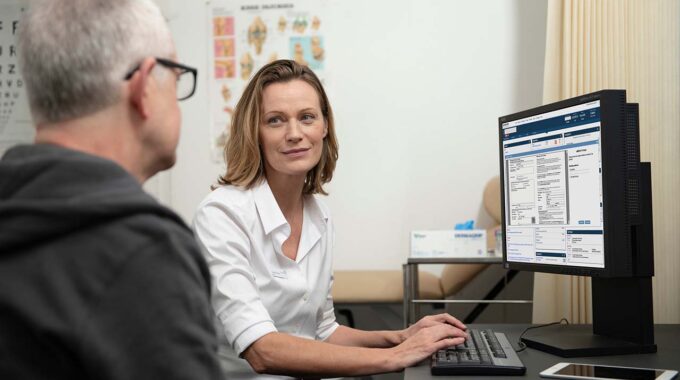Northampton General Hospital NHS Trust (NGH) has signed a ten-year contract with Nervecentre to implement…
Singing from a different HIMSS sheet
Introducing the next generation of EPR
Old tools and dated metrics won’t fix the problems of a modern NHS. Nervecentre’s Paul Volkaerts explains why it’s time for the next generation of EPR – and outlines the seven key pillars of an effective system.
The journey towards better connected, paperless hospitals is entering a new phase. After years of rhetoric, the true value of Electronic Patient Record (EPR) systems that capture, integrate and share crucial patient information at the point of care, is poised to hit the headlines. It’s about time. The current challenges facing the NHS mean we can no longer afford to squander technological opportunities or rely on old ways of working that compromise safe, timely care. Thankfully, the signs are good; the next generation of EPR is on its way.
NHS England’s continued focus on the digital capabilities of acute trusts, strengthened by the recent commissioning of an independent evaluation of its Global Digital Exemplar (GDE) programme, is a clear recognition of the vital role that technology can play in the delivery of high quality acute care. At the heart of the approach, GDEs have been explicitly challenged to reach Stage 7 of the HIMSS EMR adoption model (EMRAM). EMRAM is globally accepted as the best means of measuring a hospital’s digital maturity, with Stage 7 its highest level. However, it’s a strange quirk of the HIMSS model that even achieving its highest accreditation still won’t solve the problems that NHS hospitals most want to fix. Confused? Let me explain.
Twin challenge: safety and flow
The biggest challenges facing acute trusts in today’s highly pressured NHS are around patient safety and flow. The two go hand-in-hand.
As hospital attendances escalate, patient flow has become a high priority, with the challenge of matching capacity with demand now a growing problem for acute trusts in England. The ‘winter crisis’ of 2017/18 merely highlighted the scale. But the problem is more than operational; poor patient flow is a threat to patient safety. If patients aren’t in the right place, having the right treatment at the right time, they’re getting sub-optimal care. Fixing flow is therefore a fundamental objective of high quality acute care.
Hospitals’ focus on safety is, at face value, business as usual; patient safety is the primary goal of every acute trust. However, recommendations in the wake of the Mid Staffs inquiry, further developed in the Next Steps on the NHS Five Year Forward View, have led to a more nuanced focus on how hospitals recognise and respond to patient deterioration. This can be seen in efforts to improve the management of sepsis and other hospital acquired infections. At the national level, there is huge emphasis being placed on reducing serious incidents and improving incident reporting.
So how does all this relate to the pursuit of digital maturity and the role of EPR? The stark reality is that trusts aren’t focused on the journey to paperless care. Right now, they have two primary concerns; the condition of the patient and the condition of the hospital. Patient deterioration and capacity and flow are the biggest challenges facing modern-day trusts. To fix them, they need access to accurate information in real time. That’s where EPR comes in. But despite the push for digital excellence, HIMSS doesn’t quite do enough to help us. Here’s why.
Yesterday’s EPR
For all that is good about EMRAM – and, let’s be clear, the functionality outlined in its 8-stage model will be essential in the hospitals of the future – none of its requirements call out to the real-time demands of managing patient safety and flow. The clues are in the criteria. A key underpinning of EMRAM Stage 7 is that ‘clinically relevant information must exist in the EMR within 24 hours of creation’. Yes, that’s right: 24 hours. Let that sink in.
In the fast-paced environment of patient care, 24 hours does not help the clinician trying to treat a deteriorating patient. And it doesn’t help the site matron find a bed for the patient in A&E who’s spent 12 hours on a trolley. Electronic patient records that are 24-hours out of date, quite literally, belong in another day. Yesterday’s tools won’t solve the present-day challenges of safety and flow. Healthcare moves in real time – our technology must do its best to follow it.
Surprisingly, according to HIMSS Analytics, the 24-hour target still proves to be the biggest hurdle for healthcare facilities trying to achieve Stage 7 EMRAM accreditation. This doesn’t need to be the case. The next generation of EPR is not a futuristic utopia, it’s built on technology that’s familiar to everyone and used by around 5 billion people all over the world. When it’s applied in healthcare it can help hospitals make progress against their biggest challenges. It can help clinicians recognise and respond to deteriorating patients through the delivery of accurate information at the hospital bedside. And it can give operations teams real-time visibility of the health of their hospital to unlock opportunities for flow. In reality, the platform for next generation EPR is already in our hands. So what does good look like?
The seven pillars of next generation EPR
The tools for next generation EPR are built on seven essential pillars.
#1: Mobile
The next generation of EPR must be mobile. It’s a no-brainer. Why? Because hospitals need to be able to consume and update patient information at a highly frequent pace – and mobile technology is the most effective means of achieving it.
For an EPR to have value, the information within it must be accurate, reliable and timely. This means persuading clinicians to capture that data at the point of care. The tools of EPR must therefore be part of the uniform. Moreover, they must be with the clinician all the time. This crucial aspect is the reason why smartphones are often more effective than tablet devices; the smartphone fits in a pocket, the iPad gets left on the desk. Certainly, mobile devices are a significant advance on historic approaches; the use of ‘computers on wheels’ typically disrupts patient engagement, while updating notes via PC at the nurse’s station generally occurs some considerable time after the clinical consultation. When an update is nearer to home-time than real-time, the risk to the patient increases and the value of EPR diminishes.
The use of mobile technology is hardly innovative – after all, there are now more mobile devices in the world than there are people. No, mobile is not new – but it is the ‘new normal’. Encouragingly, the use of mobile solutions in UK hospitals is increasing, with familiarity and convenience key reasons why user adoption is much higher than with desktop technologies. Fundamentally, the real-time information needs of clinicians and nurses are best supported by tools that can be used at the patient’s bedside without intruding on – or breaking away from – routine clinical practice. That’s why the future of EPR is mobile.
#2: Built for clinicians
The best healthcare technologies are always built by clinicians, for clinicians – but there’s not a vendor in the EPR market who would not claim to be ‘clinically-led’. So how do you tell them apart? The best early measure of effective clinical engagement is user adoption. But while the convenience of mobile solutions means they tend to be handsomely adopted, it’s easy to write bad mobile software that ultimately leads to dissatisfaction and disengagement. Sustained adoption depends on authentic, granular and ongoing clinical engagement to identify the things that are most important to doctors – and then using that insight to design simple, intuitive interfaces that help them get there in a single click. The best interfaces have a singular focus on patient priorities; they don’t clutter the user experience with requests for information that is useful to the hospital but doesn’t help the clinician. Doctors don’t care about billing information – they care about patients.
The tools for next generation EPR should be designed to fit into how clinicians work – and save them time by automating the onerous processes that take them away from patient care. Clinicians aren’t interested in technology, but they are interested in anything that will free them to spend more time with patients. Simplicity and practical utility are the signature of beautifully-designed (and therefore fanatically used) mobile tools. That’s the future of EPR.
#3. Patient safety
If an EPR system is to have value, it must focus on clinicians’ primary concern: patient safety. If it cannot support doctors in this crucial area, it fails. The need for real-time intelligence is paramount, particularly when patients’ circumstances can change quickly and without warning. All of which places huge importance on the timeliness and accuracy of information. A patient record that is one minute out of date (let alone 24 hours) has no value to the clinician; it compromises care. It’s why when a patient’s condition deteriorates, old EPR systems – typically built to record clinical history rather than as tools to support active patient care – do not help doctors in the here and now. And it’s why modern EPRs must provide a real-time lens so that clinicians can respond to deterioration before it’s too late.
Evidence shows that poor communication between clinical teams is a major contributory factor in avoidable patient deaths in acute settings. Moreover, NICE guidance to support the recognition and response to acute illness in adults in hospital says poor communication and documentation are common factors in suboptimal care. Timing is everything. Mobile technology can close the gaps and mitigate the risk.
The next generation of EPR must empower clinicians with tools that assist both the early recognition of physiological deterioration and the timely escalation of treatment. These can only be achieved with solutions that are used at the patient’s bedside and that live in the pockets of clinical teams.
#4. Patient flow
In the same way that the health of a patient can quickly change, the health of a hospital is in a permanent state of flux. Maintaining the safety of patients therefore requires an operational visibility that keeps time with, and responds to, rapid and unpredictable change. However, the old tools of EPR were not built to provide a window to patient flow. Next generation EPR cannot make the same mistake.
Technology can play a huge role in driving operational efficiency and improving flow. Fuelled by the convenience of mobile technology, modern EPRs will enable multidisciplinary teams to capture, update and share real-time bed state information to inform safer patient flow. This will finally give trusts real-world visibility of their bed space and help operations teams identify potential availability or where barriers to flow exist. What’s more, when visibility and connectivity extends across the health and care system, discharge planning becomes more collaborative and proactive, allowing patients who no longer need acute care to leave hospital sooner. That’s the lifeblood of good patient flow – and the hallmark of mobile connectivity.
#5. Paperless
It goes without saying that the next generation of EPR will support the paperless agenda. The electronic capture of vital signs, handover information and nursing risk assessments should be basic requirements of a modern EPR. But rather than wait 24 hours for the electronic record to catch up with reality, modern tools will update in real time and with a single click. And they’ll drive huge efficiencies too. Those efficiencies can extend right across the pathway, automating a wide range of time-consuming tasks; GP correspondence, order comms, specialist referrals, transfers of care, death certification and coroner referrals.
#6. Open and interoperable
The Five Year Forward View is underpinned by a fundamental belief that the effective use of information and technology can fuel better patient care. But to optimise information and use it to inform decision-making, hospitals need to integrate all their key data sets so they can see the bigger picture. As the Wachter Report says, this requires a cultural change to ensure data sharing and interoperability become core characteristics of the NHS digital ecosystem.
The next generation of EPR must therefore be open, interoperable and built on a willingness to share information. It’s not enough for a system simply to ‘work with’ another; modern solutions should enable bidirectional data sharing, so that when information is updated in one system, it’s automatically updated in the other systems that connect with it too. The best EPRs will be borderless. Moreover, they will be built with open interfaces that embrace innovation and make interoperability real.
#7. Patient-centred
Finally – and most important of all – modern EPR must focus on the needs of the patient. That shift is already happening. The difference between EMR and EPR is more than a matter of semantics. The old tools of EMR, reflected in the EMRAM model, focus wholly on the ‘medical record’. Conversely, EPR (quite literally) puts the patient at the centre – capturing all the relevant information that supports active, real-time care.
But the next generation EPR will go further. As technology advances and consumer behaviours evolve, the ways in which people engage with their health are being transformed. The consumerisation of digital – powered by digital channels, wearable technology and the Internet of Things – is redefining our expectations of healthcare. The NHS must respond. As technology, culture and patient expectations evolve, modern EPR must have the capability to evolve with them.
Moreover, as the pace of digital consumerisation accelerates, the volume of information patients have on their own health will explode. This will lead to a seismic shift; from hospitals giving patients access to their records, to patients allowing hospitals to access their records. Modern EPRs must go beyond simple ‘patient access’ to support and facilitate the shift from patient enablement to patient empowerment.
That’s the next part of the journey. But for now, next generation EPRs must provide a platform to bring patients into the conversation and place them right at the heart of the system. After all, there’s no better way to connect patients than giving them the same tools used by 5 billion people worldwide.
A different HIMSS sheet
NHS England’s steadfast commitment to the technological evolution of health and care is both welcome and important. The message is clear: technology must play a leading role in the care models of the future. Digital maturity will therefore be an essential ingredient in the delivery of safe, high quality acute care. But the ways in which that maturity is measured – and the technologies designed to achieve it – must reflect the real-world needs of a pressurised NHS. It’s time for change. The present-day challenges of patient deterioration and patient flow will not be fixed by using yesterday’s tools. Real-time problems require real-time solutions that offer utility, accessibility and visibility at the point of clinical care. Those solutions are already in our hands.
It’s time to sing from a different HIMSS sheet – and leverage the next generation of EPR.



